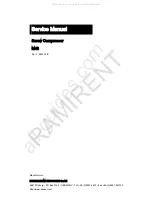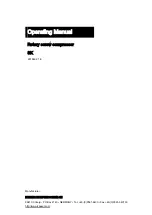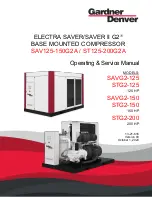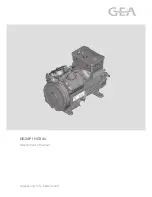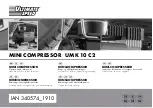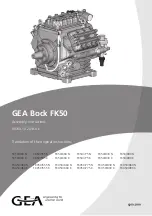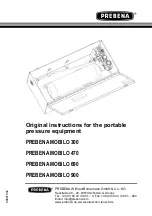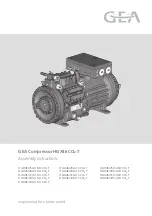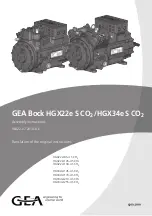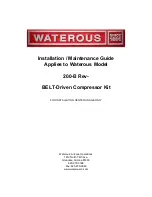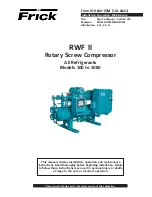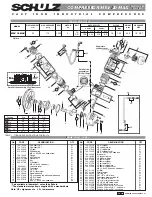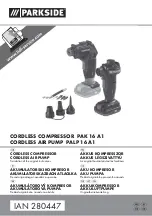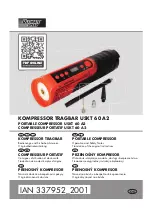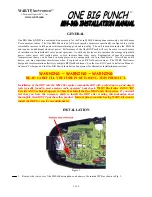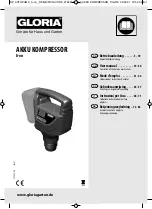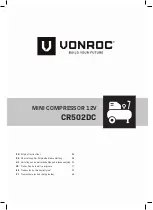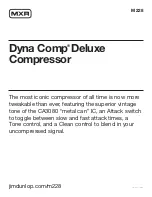
Modelos Verticales
23 Sp
Problema
Posible(s) Causa(s)
Acción a Tomar
Baja presión de salida
El motor no funciona o se
prende y se apaga
NOTA:
Los modelos
eléctricos tienen un
presostato que apaga el
motor automáticamente
cuando la presión del
tanque alcanza un nivel
fijado. Una vez que se
consuma el aire en el
tanque y la presión baje a
un nivel fijado, el
presostato enciende
automáticamente el motor.
Desgasto excesivo de las
bandas
Ruido excesivo (golpea)
El aire expulsado tiene
residuos de aceite
1. Hay fugas de aire
2. Las bandas se deslizan
3. La entrada de aire está obstruída
4. Los empaques están dañados
5. Las válvulas tienen fugas
1. El cortacircuito se activa, el sistema
eléctrico está sobrecargado
2. Le falta aceite
3. El sistema de protección del motor
se activa, la unidad se
sobrecalienta
4. Las válvulas de chequeo están
dañadas
5. El presostato esta dañado
6. El motor está sobrecargado
1. La polea está desalineada
2. La banda está muy floja o muy
apretada
3. La banda se desliza
4. La polea osciila
1. El motor o la polea el compresor
están flojos
2. Le falta aceite a la caja del
cigüeñal
3. El pistón toca la placa de la válvula
4. La válvula de chequeo hace ruido
1. El respiradero está obstruído
2. La entrada de aire del compresor
está obstruída
3. El compresor tiene mucho aceite
4. Usó un aceite inadecuado
5. Los anillos del pistón están
dañados
1. Revise a ver si hay fugas de aire. Aplíquele agua enjabonada en
todas las conexiones. Si hay fugas verá burbujas de aire donde las
haya. Un poco de burbujas no es muy importante. Si hay rocío,
apriete o reemplace la conexión
2. Afloje los pernos del motor y sepárelo del compresor. Cerciórese de
que la polea del motor esté alineada con el volante. Apriete los
pernos del motor. La banda debe tener una deflexión de 12,7 mm
(1/2”) al aplicarsele una fuerza de 2,27 kg. No “enrolle” la banda
en las poleas
3. Limpie el elemento del filtro
4. Reemplace cualquier empaque que encuentre dañado
5. Sáquele la culata y revísela para ver si la válvula, los asientos de las
válvulas, etc están dañados. Reemplace las piezas dañadas y
ensamble las piezas
Cerciórese de reemplazar el
empaque de la culata cada vez
que desmonte la culata
1. Apague todos los otros artefactos conectados al mismo circuito.
Active el cortacircuito o reemplace el fusible
2. Mídale el aceite. Añádale aceite si es necesario. Chequée si alguna
pieza se daño al funcionar con poco aceite. Reemplace las piezas
dañadas si es necesario
3. Espere a que el motor se enfríe y oprima el botón del sistema de
protección del motor
4. Reemplácelas
5. Reemplácelo
6. Un electricista calificado debe chequear el motor y el alambrado y
hacer las reparaciones necesarias. Chequée las conexiones del
voltaje del motor
1. Alinée la polea del motor con la del compresor
2. Ajuste la tensión (Vea la sección “Bandas”)
3. Ajuste la tensión o reemplace la banda (Vea la sección “Bandas”)
4. Chequée si la chavetera del cigüeñal o el orificio interno de la polea
se dañaron cuando el compresor o el motor funcionaron con las
poleas flojas. Chequée a ver si las poleas o el cigüeñal están
doblados
1. Una causa coúmn de este problema es que las poleas del motor o el
compresor están flojas. Apriete los pernos y tornillos de la polea
2. Mídale el aceite; si le falta aceite, cerciórese de que los cojinetes no
se hayan dañado. El aceite sucio puede ocasionar desgasto excesivo
3. Sáquele la culata y la placa de la válvula al compresor y revíselo para
ver si hay depósitos de carbón u otras impurezas en la parte
superior del pistón. Colóquele la culata y la placa de la válvula
usando un empaque nuevo
4. Reemplácela
1. Limpie el respiradero y revíselo para ver si está funcionando
adecuadamente
2. Limpie el filtro. Chequée el sistema de entrada para ver si tiene
alguna obstrucción
3. Drene el aceite hasta alcanzar el nivel marcado (full) (lleno)
4. Use aceite industrial para compresores SAE 30
5. Reemplace los anillos
!
PRECAUCION
Guía de Diagnóstico de Averías
the system before attempting to
install, service, relocate or perform any
maintenance.
LOCATION
This compressor is
not intended for
outdoor installation.
It is extremely important to install the
compressor in a clean, well ventilated
area where the surrounding air
temperature will not be more than 100°F.
Provide a minimum clearance of 18
inches between the compressor
flywheel or fan to the wall and ensure
clear access to the drain cock to
facilitate condensate drainage.
Do not locate the compressor air inlet
near steam, paint spray, sandblast areas
or any other source of contamination.
MOUNTING
Never use the
wood shipping
skids for mounting the compressor.
FLOOR MOUNTING
(All Units)
If the unit is not secured with the wall
cable, the compressor feet
MUST
be
bolted to a flat, even, concrete floor or
separate concrete foundation.
Vibration isolators
must be
used
between the tank leg and the floor. Do
not draw bolts tight. Allow the pads to
absorb vibrations. A flexible coupling
should be installed between the tank
and service piping.
This compressor is
extremely top
heavy. The unit must be bolted to the
floor with isolation pads or secured
with the wall cable (if provided)
before operating to prevent
equipment damage, injury or death.
WALL CABLE INSTALLATION
(Provided on some 30 gallon models)
Included with the safety cable are two
lag screws and washers.
1. Place an isolation pad beneath each
foot of the compressor to minimize
vibration.
2. Position the cable through the
baseplate as shown in Figure 2.
3. Place the screws through the
washers then through looped ends
of cable.
!
NOTICE
deterioration, weakness or leakage.
Repair or replace defective items
before using.
8. Check all fasteners at frequent
intervals for proper tightness.
Motors, electrical
equipment and controls
can cause electrical arcs
that will ignite a flammable gas or
vapor. Never operate or repair in or
near a flammable gas or vapor. Never
store flammable liquids or gases in the
vicinity of the compressor.
Never operate compressor
without a beltguard. This
unit can start automatically
without warning. Personal injury or
property damage could occur from
contact with moving parts.
9. Do not wear loose clothing or
jewelry that will get caught in the
moving parts of the unit.
Compressor parts may be
hot even if the unit is
stopped.
10. Keep fingers away from a running
compressor; fast moving and hot
parts will cause injury and/or burns.
11. If the equipment should start to
vibrate abnormally, STOP the
engine/motor and check
immediately for the cause. Vibration
is generally a warning of trouble.
12. To reduce fire hazard, keep
engine/motor exterior free of oil,
solvent, or excessive grease.
An ASME code
safety relief valve
with a setting no higher than 150 psi
MUST be installed in the tank for this
compressor. The ASME safety valve
must have sufficient flow and pressure
ratings to protect the pressurized
components from bursting.
Maximum operat-
ing pressure is 125
psi. Do not operate with pressure switch
or pilot valves set higher than 125 psi.
13. Never attempt to adjust ASME
safety valve. Keep safety valve free
from paint and other accumulations.
2
Stationary Air Compressor
Never use plastic
(PVC) pipe for
compressed air. Serious injury or death
could result.
Never attempt to repair or
modify a tank! Welding,
drilling or any other
modification will weaken the tank
resulting in damage from rupture or
explosion. Always replace worn,
cracked or damaged tanks.
Drain liquid from
tank daily.
14. Tanks rust from moisture build-up,
which weakens the tank. Make sure
to drain tank regularly and inspect
periodically for unsafe conditions
such as rust formation and corrosion.
15. Fast moving air will stir up dust and
debris which may be harmful. Release
air slowly when draining moisture or
depressurizing the compressor system.
SPRAYING PRECAUTIONS
Do not spray flammable
materials in vicinity of
open flame or near
ignition sources including the
compressor unit.
16. Do not smoke when spraying paint,
insecticides, or other flammable
substances.
17. Use a face mask/
respirator when
spraying and spray in a
well ventilated area to
prevent health and fire
hazards.
18. Do not direct paint or other
sprayed material at the compressor.
Locate compressor as far away from
the spraying area as possible to
minimize overspray accumulation
on the compressor.
19. When spraying or cleaning with
solvents or toxic chemicals, follow
the instructions provided by the
chemical manufacturer.
Disconnect, tag and lock
out power source, then
release all pressure from
!
NOTICE
General Safety
(Con’t)
Installation


















